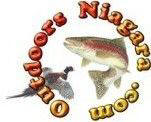
OUTDOORS
NIAGARA
"It's yours, use it,
protect it, share it"
"Niagara's
Premier Outdoors Website"
"Most informative and up to date outdoors website on the
planet"

 |
OUTDOORS
NIAGARA |
|
|
Illustration
from a field guide prepared by the The eye of the blue
pike, bottom, is much larger |
 |
Go back to blue pike index page
Protective measures already taken: In 1969, a pair of Lake Erie Stizostedion, believed to be blue pike, were spawned at the Pennsylvania Fish Commission's Linesville Fish Culture Station. About 9,000 of the fry were transferred to Gavins Point National Fish Hatchery at Yankton, South Dakota. Some of the fingerlings were stocked in an isolated lake in northern Minnesota.
Remarks:
Data submitted by Dr. Stanford H. Smith, National Marine Fisheries Service, Ann
Arbor, Michigan and Region 3, U. S. Fish and Wildlife Service, Twin Cities,
Minnesota.
Selected References
Hubbs, C. L. and K. F. Lagler. 1964. Fishes of the Great Lakes region.
University of Michigan Press, 213 pp.
Trautman, M. B. 1957. The fishes of Ohio. Ohio State University Press, 683 pp.
Parsons, John W. 1967. Contributions of year-classes of blue pike to the
commercial fishery of Lake Erie, 1943-59. J. Fish. Res. Bd. Canada,
24(5):1035-1066.
More
information
from
The
Woodrow Wilson National Fellowship Foundation CN 5281, Princeton NJ
Blue Pike. The blue pike (Stizostedion vitreum glaucum) was abundant in the commercial fishery of the Great Lakes. It was historically found in Lakes Erie and Ontario, and in the Niagara River. ~ 1915, population levels began a cycle of extreme fluctuation caused by over-fishing, leading to the eventual collapse in 1958. The FWS listed the pike as endangered under the ESCA in 1970. suggesting that introgressive hybridization with walleye may have caused the final disappearance of the stock. A survey by the Blue Pike Recovery Team in 1977 found no individuals. In 1983, the EWS declared the blue pike extinct and removed it from the endangered species list (48 FR 39942).
About Extinct Species
Of the 1,676 species on the Lists of Endangered and Threatened Wildlife and Plants (as of November 30, 1997), seven have been delisted due to extinction. Four of these species -- the Tecopa pupfish, longjaw cisco, blue pike, and Santa Barbara song sparrow -- were protected under laws pre-dating the ESA, and therefore were automatically listed under the ESA when it passed in 1973. They were apparently already extinct by 1973, however.